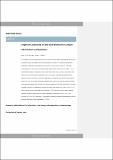Files in this item
Oxygen ion conductivity in ceria-based electrolytes co-doped with samarium and gadolinium
Item metadata
| dc.contributor.author | Coles-Aldridge, Alice V. | |
| dc.contributor.author | Baker, Richard T. | |
| dc.date.accessioned | 2021-02-14T00:39:31Z | |
| dc.date.available | 2021-02-14T00:39:31Z | |
| dc.date.issued | 2020-04 | |
| dc.identifier | 266485275 | |
| dc.identifier | 30683dcc-7991-4cd4-b10c-c7bf6f9879a8 | |
| dc.identifier | 85079293394 | |
| dc.identifier | 000531573600024 | |
| dc.identifier.citation | Coles-Aldridge , A V & Baker , R T 2020 , ' Oxygen ion conductivity in ceria-based electrolytes co-doped with samarium and gadolinium ' , Solid State Ionics , vol. 347 , 115255 . https://doi.org/10.1016/j.ssi.2020.115255 | en |
| dc.identifier.issn | 0167-2738 | |
| dc.identifier.other | ORCID: /0000-0002-3304-3280/work/69463345 | |
| dc.identifier.uri | https://hdl.handle.net/10023/21427 | |
| dc.description | The authors thank the University of St Andrews and the UK Engineering and Physical Sciences Research Council for the PhD studentship for AVC-A (grant code: EP/M506631/1). Electron microscopy was performed at the Electron Microscope Facility, University of St Andrews. | en |
| dc.description.abstract | In a systematic study, two compositional series of ceria-based oxides, both co-doped with Sm and Gd, were synthesised using a low temperature method and evaluated as oxygen ion-conducting electrolytes for Intermediate Temperature Solid Oxide Fuel Cells (IT-SOFCs). Series one, Ce1-2xSmxGdxO2-x, had equal concentrations of Sm and Gd but varying total dopant concentration. Series two, Ce0.825SmxGd0.175-xO1.9125, had a fixed total dopant concentration but the Sm:Gd concentration ratio was varied. The materials were characterised using scanning and transmission electron microscopy, inductively coupled plasma mass spectrometry and X-ray diffraction. Impedance spectra were recorded on dense pellets of these materials. From these, total, bulk and grain boundary conductivities and capacitances along with activation energies, pre-exponential constants and enthalpies of ion migration and defect association were obtained. These gave a detailed insight into the fundamental conduction processes in the materials. Ce0.825Sm0.0875Gd0.0875O1.9125 had the highest total ionic conductivity at temperatures of 550 °C and above and also demonstrated an enhanced conductivity with respect to its singly-doped parent compounds, Ce0.825Sm0.175O1.9125 and Ce0.825Gd0.175O1.9125, at 400 °C and above. This compares favourably with previously-reported values and has promising implications for the development of IT-SOFCs. | |
| dc.format.extent | 2027384 | |
| dc.language.iso | eng | |
| dc.relation.ispartof | Solid State Ionics | en |
| dc.subject | Activation energy | en |
| dc.subject | Ceria | en |
| dc.subject | Doping | en |
| dc.subject | Electrolyte | en |
| dc.subject | Ionic conductivity | en |
| dc.subject | Solid oxide fuel cell | en |
| dc.subject | QD Chemistry | en |
| dc.subject | Chemistry(all) | en |
| dc.subject | Materials Science(all) | en |
| dc.subject | Condensed Matter Physics | en |
| dc.subject | DAS | en |
| dc.subject.lcc | QD | en |
| dc.title | Oxygen ion conductivity in ceria-based electrolytes co-doped with samarium and gadolinium | en |
| dc.type | Journal article | en |
| dc.contributor.institution | University of St Andrews. School of Chemistry | en |
| dc.contributor.institution | University of St Andrews. St Andrews Sustainability Institute | en |
| dc.contributor.institution | University of St Andrews. EaSTCHEM | en |
| dc.identifier.doi | 10.1016/j.ssi.2020.115255 | |
| dc.description.status | Peer reviewed | en |
| dc.date.embargoedUntil | 2021-02-14 |
This item appears in the following Collection(s)
Items in the St Andrews Research Repository are protected by copyright, with all rights reserved, unless otherwise indicated.

